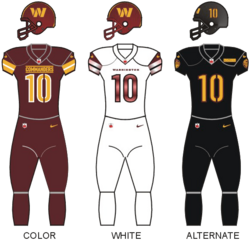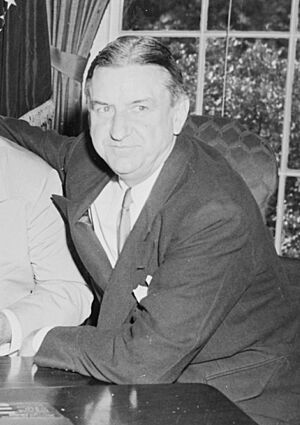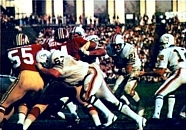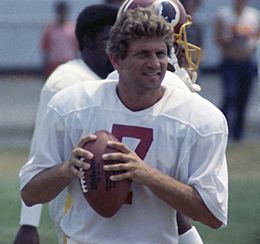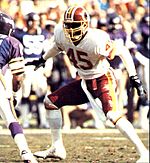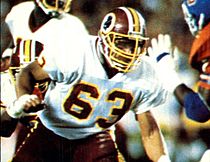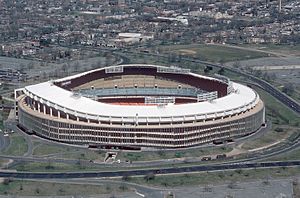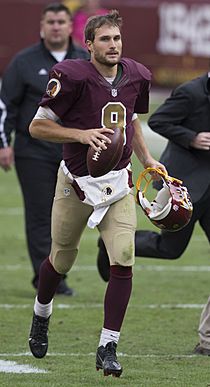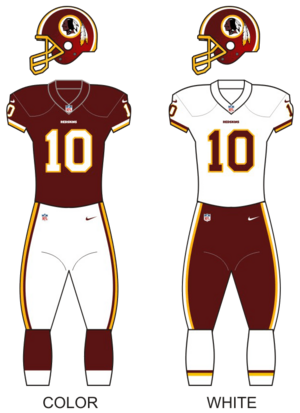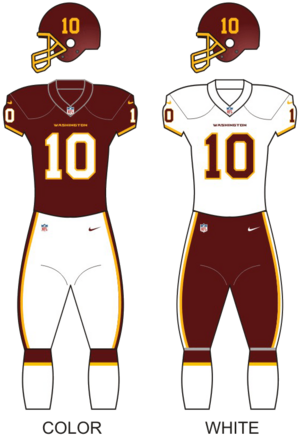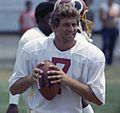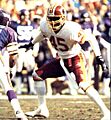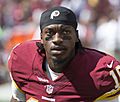Washington Commanders facts for kids
Quick facts for kids Washington Commanders |
|||||||||||||
|---|---|---|---|---|---|---|---|---|---|---|---|---|---|
|
|||||||||||||
| Basic info | |||||||||||||
| Established | July 9, 1932 | ||||||||||||
| Colors | Burgundy, gold, white |
||||||||||||
| Fight song | "Hail to the Commanders" | ||||||||||||
| Mascot | Major Tuddy | ||||||||||||
| Personnel | |||||||||||||
| Owner(s) | Daniel Snyder | ||||||||||||
| CEO | Tanya Snyder | ||||||||||||
| President | Jason Wright | ||||||||||||
| General manager | Martin Mayhew | ||||||||||||
| Head coach | Ron Rivera | ||||||||||||
| Nicknames | |||||||||||||
|
|||||||||||||
| Team history | |||||||||||||
|
|||||||||||||
| Home fields | |||||||||||||
|
|||||||||||||
| League / conference affiliations | |||||||||||||
National Football League (1932–present)
|
|||||||||||||
| Championships | |||||||||||||
League championships: 5
|
|||||||||||||
Conference championships: 5
|
|||||||||||||
Division championships: 15
|
|||||||||||||
| Playoff appearances (25) | |||||||||||||
|
|||||||||||||
The Washington Commanders are a professional American football team. They are based in the Washington metropolitan area. The Commanders play in the National Football League (NFL). They are part of the National Football Conference (NFC) East division. The team plays its home games at FedExField in Landover, Maryland. Their main office and training area are in Ashburn, Virginia.
The team has played over 1,000 games. It is one of only five NFL teams with more than 600 total wins. Washington was one of the first NFL teams to have a fight song. It is called "Hail to the Commanders". Their marching band plays it after every touchdown at home. In 2022, Forbes magazine said the team was worth about $5.6 billion. This made them the sixth most valuable team in the league.
The team started in 1932 as the Boston Braves. The next year, they changed their name to the Redskins. They then moved to Washington, D.C., in 1937. The "Redskins" name was seen as offensive by many people for a long time. In 2020, the team decided to change its name. This happened because of pressure from NFL sponsors and a new focus on the Native American mascot controversy. The team played as the Washington Football Team for two seasons. In 2022, they officially became the Commanders.
Washington has won five championships. They won the 1937 and 1942 NFL championships. They also won XVII, XXII, and XXVI. The team has been the league runner-up six times. They lost the 1936, 1940, 1943, and 1945 title games. They also lost VII and XVIII. They have won 14 division titles and made 24 playoff appearances. Their playoff record is 23 wins and 18 losses. Their three Super Bowl wins tie them with the Denver Broncos and Las Vegas Raiders.
All of Washington's championships came during two ten-year periods. From 1936 to 1945, they played in the NFL Championship six times, winning two. The second successful period was from 1982 to 1991. During this time, they made the playoffs seven times. They won four Conference titles and three Super Bowls. From 1946 to 1970, Washington had only four winning seasons. They did not make the playoffs during this time. They had no winning seasons from 1956 to 1968. Their worst record was 1–12–1 in 1961. Since the 1991 season, when they last won the Super Bowl, they have won the NFC East four times. They have had nine winning seasons and made the playoffs seven times.
Contents
Team History
Early Years (1932–1968)
The NFL gave a team to the city of Boston on July 9, 1932. The owner was George Preston Marshall. The team was named the "Boston Braves". They shared their stadium, Braves Field, with the Boston Braves baseball team. The next year, the team moved to Fenway Park. This was the home of the Boston Red Sox. The team also changed its name to the "Redskins". Marshall hired William Henry "Lone Star" Dietz as the head coach. Dietz said he was part Sioux.
Winning Seasons (1936–1942)
The Redskins played in their first championship game in 1936. They lost to the Green Bay Packers 21–6.
First NFL Championship (1937)
After five years in Boston, the Redskins moved to Washington, D.C. Marshall said Boston did not show enough interest in the team. Until 1960, the team played at Griffith Stadium. They shared it with the Washington Senators baseball team. In their first game in Washington, the Redskins beat the New York Giants 13–3. That same season, they won their first division title in Washington. They beat the Giants 49–14. Soon after, they won their first league championship in 1937. They defeated the Chicago Bears.
In 1940, the Redskins played the Bears again in the 1940 NFL Championship Game. The Bears won 73–0. This is still the biggest loss in NFL history.
Second NFL Championship (1942)
The Redskins and Bears met two more times in the NFL Championship Game. In 1942, the Redskins won their second championship, 14–6. This became an early rivalry in the NFL.
Later Years of the Marshall Era (1943–1968)
In 1943, Dutch Bergman became head coach. He led the team back to the NFL championship game. However, they lost to the Chicago Bears 41–21. That season, Sammy Baugh was a star player. He led the NFL in passing, punting, and interceptions.
The Redskins played in one more NFL Championship before a long break. This break lasted until the 1972 season. With Dudley DeGroot as their new coach, the Redskins went 8–2 in the 1945 season. Sammy Baugh had a great year, completing 70.3% of his passes. They lost to the Cleveland Rams 15–14 in the 1945 NFL Championship Game. The one-point loss was controversial because of a safety early in the game. This led to a rule change called the "Baugh/Marshall Rule."
After 1945, the Redskins had a tough time. They did not do well until a playoff appearance in the 1971 season. From 1946 to 1951, the Redskins had four different head coaches. None of them were very successful. On June 14, 1950, the American Oil Company started televising all Redskins games. This made Washington the first NFL team to have all its games on TV.
In 1961, the Redskins moved to a new stadium. It was called D.C. Stadium. It was later renamed Robert F. Kennedy Memorial Stadium in 1969. The first game there was on October 1. The Redskins lost to the New York Giants 24–21. That same year, Bill McPeak became head coach. He coached for five seasons. During his time, he helped draft future stars like Charley Taylor and Jerry Smith. He also helped trade for quarterback Sonny Jurgensen and linebacker Sam Huff.
Owner George Preston Marshall's health declined in 1962. After he died in 1969, Edward Bennett Williams took over running the team. In 1966, Otto Graham became the new head coach. He coached for three seasons. He resigned after the 1968 season.
Jack Kent Cooke Era (1969–1998)
In 1969, the Redskins hired Vince Lombardi as their new head coach. Lombardi was famous for coaching the Green Bay Packers. He led the team to a 7–5–2 record. This was their best record since 1955. Sadly, he died of cancer before the 1970 season began. Assistant coach Bill Austin was the interim head coach in 1970. Washington finished 6–8.
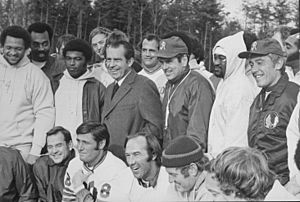
George Allen Years (1971–1977)
After Lombardi's death, George Allen became head coach on January 6, 1971. Allen liked older, experienced players. His teams were known as the Over-the-Hill Gang. In 1971, the Redskins made the playoffs. This was their first time since 1945. They had a 9–4–1 record. Allen won the 1971 NFL Coach of the Year Award. However, they lost in the playoffs to the San Francisco 49ers 24–20.
The next season, the Redskins hosted their first home playoff game since 1942. They beat the Green Bay Packers 16–3. The Redskins then reached the NFC Championship Game. They played their rivals, the Dallas Cowboys. The Redskins won 26–3. After winning the NFC Championship, the Redskins lost to the undefeated Miami Dolphins 14–7 in Super Bowl VII. Redskins running back Larry Brown was named the 1972 NFL's Most Valuable Player.
The Redskins made the playoffs again in 1973, 1974, and 1976. But they lost in the first round each time. After the 1977 season, Allen was fired. Jack Pardee became the new head coach. In his first year, his team started 6–0. But then they lost 8 of their last 10 games. Owner Jack Kent Cooke then moved to Virginia and took over daily team operations.
The Redskins drafted future stars Don Warren and Monte Coleman in the 1979 NFL Draft. They started the 1979 season 6–2. They were 10–5 going into the last game against the Cowboys. A win would have put them in the playoffs. Washington led 34–28, but the Cowboys made a comeback. The 35–34 loss knocked the Redskins out of the playoffs. Pardee was named Associated Press Coach of the Year. However, he was fired after a 6–10 record in 1980. He did draft Art Monk in the first round.
Joe Gibbs Era (1981–1992)
On January 13, 1981, owner Jack Kent Cooke hired Joe Gibbs as head coach. Gibbs was the offensive coordinator for the San Diego Chargers. The Redskins also got Mark May, Russ Grimm, and Dexter Manley in the 1981 NFL Draft. These players helped the team a lot. After starting the 1981 season 0–5, the Redskins won eight of their next 11 games. They finished the season 8–8.
Super Bowl XVII Champions (1982)
The NFL faced a 57-day player strike starting September 21, 1982. This made the 1982 season only nine games long. After the strike, the Redskins played very well. They won six of their last seven games. This got them into the playoffs for the first time since 1976.
In January 1983, during the playoffs, John Riggins ran for a Redskins playoff record 185 yards. Washington won 21–7 against the Minnesota Vikings. In the NFC Championship Game against the Cowboys, Dexter Manley injured Cowboys' quarterback Danny White. Later, Darryl Grant scored a touchdown on an interception. Riggins ran for 140 yards and two touchdowns. The Redskins beat the Cowboys 31–17.
The Redskins won their first Super Bowl, Super Bowl XVII, by beating the Miami Dolphins 27–17. This was their first NFL Championship in 40 years. Riggins made a famous play. On 4th down, he ran 43 yards for a touchdown. He ran through a tackler to score. Riggins won the Super Bowl MVP.
After the 1982 season, Redskins kicker Mark Moseley was named the NFL's Most Valuable Player. He was the first and only kicker to win this award. Moseley made 20 of 21 field goals in 1982. Coach Joe Gibbs also won his first NFL Coach of the Year Award in 1982.
The 1983 season saw the debut of cornerback Darrell Green. He was drafted in the 1983 NFL Draft with Charles Mann. Green played his entire 20-year career for the Redskins. On October 1, 1983, the Redskins lost to the Green Bay Packers 48–47. This was the highest-scoring Monday night football game ever at the time.
In the regular season finale, Moseley set an NFL scoring record with 161 points. Riggins was second with 144 points. The team won 14 games. They scored an NFL record 541 points. Riggins scored 24 touchdowns. Quarterback Joe Theismann was named the 1983 NFL's Most Valuable Player. He had 3,714 passing yards and 29 touchdown passes. In the playoffs, the Redskins beat the Los Angeles Rams 51–7. The next week, Washington beat the San Francisco 49ers 24–21 in the NFC Championship Game. However, they lost to the Raiders 38–9 in Super Bowl XVIII.
The Redskins finished the 1984 season with an 11–5 record. They won the NFC East for the third year in a row. But they lost in the first round of the playoffs to the Chicago Bears 23–19. On November 18, 1985, Joe Theismann broke his leg during a game against the Giants. This injury ended his 12-year career.
In the 1986 offseason, the Redskins drafted future Super Bowl MVP Mark Rypien. Defensive end Dexter Manley set a team record with 18.5 sacks. In the 1986 season, the Redskins made the playoffs as a wild-card team. They had a 12–4 record. They won against the Rams and then the Bears in the playoffs. This Bears game was Gibbs's 70th career win. The season ended when they lost to the Giants 17–0 in the NFC Championship game.
Super Bowl XXII Champions (1987)
The 1987 season started with a 24-day players' strike. This made the season 15 games long. The Redskins won three games with replacement players. They were the only team where no regular players crossed the picket line. These three wins helped them get into the playoffs. The Redskins won their second championship in Super Bowl XXII on January 31, 1988. They beat the Denver Broncos 42–10. They came back from a 10–0 deficit. This was the biggest Super Bowl comeback at the time.
Quarterback Doug Williams had an amazing game. He threw four touchdowns in the second quarter. He became the first black quarterback to win a Super Bowl. He also won the Super Bowl MVP award. Rookie running back Timmy Smith ran for a Super Bowl record 204 yards.
The 1988 season started well, with a 5–3 record. But they finished 7–9 and missed the playoffs.
The 1989 Redskins finished 10–6 but missed the playoffs. This season is remembered for their wide receiver trio called "The Posse." Art Monk, Gary Clark, and Ricky Sanders were the first trio of wide receivers to each gain over 1,000 yards in the same season. Coach Joe Gibbs got his 100th career victory that season. The Redskins returned to the playoffs in 1990 as a Wild Card team. They lost to the 49ers in the Divisional round.
Super Bowl XXVI Champions (1991)
The 1991 season started with a team record of 11 straight wins. "The Hogs", the offensive line, allowed only nine sacks. This was the third-lowest total in NFL history. The 1991 Redskins offense scored 485 points, the most in the 1991 NFL season. The defense was also very strong. They allowed only 224 points, the second-best in the NFL. They also had three shutouts.
After a 14–2 record, the Redskins dominated the playoffs. They beat the Falcons and Lions by a combined score of 64–17. On January 26, 1992, the Redskins won Super Bowl XXVI. They defeated the Buffalo Bills 37–24. Mark Rypien won the Super Bowl MVP award. After the Super Bowl, eight Redskins players were selected for the Pro Bowl. The 1991 Washington Redskins are considered one of the best teams in NFL history.
The Redskins made the playoffs in 1992 as a wild card team. But they lost to the 49ers 20–13. On October 12, 1992, Art Monk became the NFL's all-time leading pass receiver. He caught his 820th career reception. Joe Gibbs retired on March 5, 1993, after 12 years of coaching. He started Joe Gibbs Racing in NASCAR.
After Gibbs left, the Redskins hired former player Richie Petitbon for the 1993 season. His only year as head coach, the team finished 4–12. Petitbon was fired. On February 2, 1994, Norv Turner was hired as head coach. The 1994 season was even worse, with a 3–13 record. This was their worst season in over 30 years. They improved to 6–10 in 1995. They beat the Dallas Cowboys twice that year.
On March 13, 1996, plans were made for a new stadium. The 1996 season saw Washington have their first winning record in four years, finishing 9–7. On December 22, 1996, the Redskins played their last game at Robert F. Kennedy Memorial Stadium. They beat the Dallas Cowboys 37–10. Their record at that stadium was 173–102–3, including 11–1 in the playoffs.
On April 6, 1997, owner Jack Kent Cooke died. He left the Redskins to his foundation. His son, John Kent Cooke, took over. He announced the new stadium would be named Jack Kent Cooke Stadium. On September 14, 1997, the Redskins played their first game in the new stadium. They beat the Arizona Cardinals 19–13 in overtime. They finished 1997 with an 8–7–1 record. They missed the playoffs for the fifth year in a row. Darrell Green played his 217th game as a Redskin, breaking a team record.
The 1998 season started with seven straight losses. The Redskins finished with a 6–10 record.
Daniel Snyder Era (1999–Present)
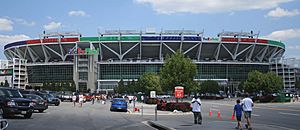

John Kent Cooke could not buy the Redskins permanently. So, on May 25, 1999, Daniel Snyder bought the team for $800 million. This was the most expensive team purchase in sports history at the time. One of his first actions was selling the naming rights to Jack Kent Cooke Stadium to FedEx. It was renamed FedExField.
In Snyder's first season as owner, the Redskins went 10–6. They made it to the playoffs for the first time since 1992. Running back Stephen Davis rushed for a team-record 1,405 yards. Quarterback Brad Johnson threw for over 4,000 yards. They beat the Detroit Lions in the first round of the playoffs. But they lost to the Buccaneers 14–13.
The 2000 season included five straight wins early on. However, they finished 7–6. Coach Turner was fired before the season ended. Terry Robiskie was interim coach. The team finished 8–8.
On January 3, 2001, the Redskins hired Marty Schottenheimer as head coach. The 2001 season began with a loss. On September 13, 2001, the Redskins started a relief fund to help victims of the September 11 attacks. They raised over $700,000. They finished the season 8–8. Schottenheimer was fired after the season.
On January 14, 2002, Snyder hired University of Florida coach Steve Spurrier. They finished 7–9. This was their first losing season in four years. On December 29, Darrell Green played his 20th and final season. He set an NFL record for consecutive seasons with at least one interception (19). The Redskins finished the 2003 season 5–11. This was their worst record since 1994. Bruce Smith broke Reggie White's all-time NFL sack record with his 199th sack. Spurrier resigned after the 2003 season.
For the 2004 season, Snyder brought back former coach Joe Gibbs. Gibbs returned as head coach and team president. Snyder also expanded FedExField to 91,665 seats. Gibbs' return did not bring instant success. The Redskins finished 6–10. The team struggled on offense. Quarterback Mark Brunell was replaced by Patrick Ramsey. However, new players like Shawn Springs and Marcus Washington played well. The Redskins also drafted Sean Taylor in Gibbs' first season.
The 2005 season started with three wins. This included a win against the Dallas Cowboys. Dallas led 13–0 with less than four minutes left. Brunell threw a 39-yard touchdown pass to Moss. Then, with 2:44 left, Brunell connected with Moss again for a 70-yard touchdown. Nick Novak kicked the winning extra point. They then lost six of their next eight games. Their playoff chances looked bad. On December 18, 2005, the Redskins beat the Cowboys 35–7. This was the first time since 1995 they swept the season series against Dallas. The Redskins made the playoffs for the first time since 1999.
Clinton Portis set a team record with 1,516 rushing yards. Santana Moss set a team record with 1,483 receiving yards. Chris Cooley broke the tight end reception record with 71 catches. In the first round of the playoffs, the Redskins beat the Buccaneers 17–10. They set a record for fewest offensive yards (120) in a playoff win. The next weekend, they lost to the Seahawks 20–10.
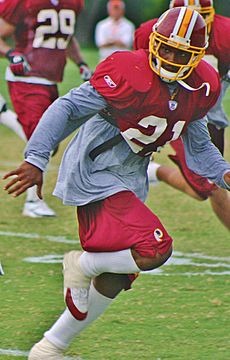
In 2006, Gibbs hired Al Saunders as offensive coordinator. The Redskins drafted future starters Rocky McIntosh and Anthony Montgomery. After winning only three of their first nine games, Gibbs benched Brunell for Jason Campbell. Campbell got his first NFL victory against the Carolina Panthers. On November 5, the Redskins beat Dallas 22–19 with a last-second field goal. However, the Redskins finished the year 5–11. This was their second losing season under Gibbs in his second time as coach.
The Redskins started the 2007 season 2–0. They kept winning and losing close games. They were 5–3 at the halfway point. On November 26, Redskins safety Sean Taylor was shot by home intruders. He died the next morning. The Redskins rallied and finished 9–7. They clinched the final playoff spot. Washington trailed the Seattle Seahawks 13–0 in the Wild Card round. They came back to lead 14–13. But they lost 35–14 after two late interceptions.
After Joe Gibbs retired in 2007, Jim Zorn was hired as head coach. The 2008 season started well, with a 6–2 record. Running back Clinton Portis led the NFL in rushing yards. But the team struggled later, finishing 8–8 and missing the playoffs. In 2009, they finished 4–12. Zorn was fired and replaced by Mike Shanahan.
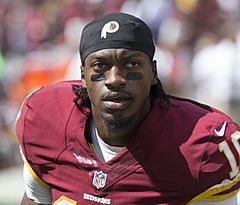
On April 4, 2010, the Redskins got Donovan McNabb in a trade. But they finished 6–10. McNabb was traded in August 2011. The Redskins then had no major offensive players except Santana Moss. Mike Shanahan named Rex Grossman as the starting quarterback. In Week 1, Grossman threw for 305 yards and two touchdowns. The Redskins beat the Giants 28–14. Washington started 2–0 but finished 5–11. However, they beat the New York Giants twice, who later won the Super Bowl.
In 2012, the Redskins traded draft picks to get quarterback Robert Griffin III. He was the second overall pick in the 2012 NFL Draft. In the first game, Griffin threw for 320 yards and two touchdowns. The Redskins won 40–32 against the New Orleans Saints. The Redskins started 3–6. But in Week 11, they beat the Eagles 31–6. Griffin had one of his best games. The Redskins won their next six games. This included the final game against the Cowboys, which won them the division title. They hosted the Seattle Seahawks in the Wild Card round but lost 24–14.
Hopes were high for 2013. But the 2013 season was a disaster, with a 3–13 record. Pierre Garçon had his best season. He broke Art Monk's record for catches in a single season with 113. The Redskins fired Shanahan after the season.
On January 9, 2014, the Redskins hired Jay Gruden as head coach. Gruden was the eighth head coach under Daniel Snyder. The Redskins struggled, finishing 4–12.
On January 7, 2015, the Redskins hired Scot McCloughan as general manager. In October 2015, the Redskins had their biggest comeback win. They were down 0–24 against the Tampa Bay Buccaneers but won 31–30. The Redskins won the NFC East division title on December 26. They beat the Philadelphia Eagles 38–24. This was their third division title under Snyder. The Redskins hosted the Green Bay Packers in the Wild Card round on January 10, 2016, but lost 35–18. Quarterback Kirk Cousins finished the season with career highs in touchdowns (29) and yards (4,166).
The team's offense in 2016 set several team records. They had over 6,000 total yards. Kirk Cousins set single-season team records for attempts, completions, and passing yards. Many players had over 500 yards from scrimmage. Despite this, the Redskins missed the playoffs. They lost to the New York Giants in the final week. However, they finished 8–7–1. This gave them their first back-to-back winning seasons in almost 20 years. The defense had a poor season, leading to the firing of defensive coordinator Joe Barry. In 2017, Cousins had his third straight season with 4,000 passing yards. The Redskins finished 7–9 and missed the playoffs again.
In the 2018 offseason, the Redskins traded for quarterback Alex Smith. He replaced Kirk Cousins. The team started 6–3, their best start since 2008. But they finished 1–6 due to injuries. Alex Smith suffered a serious leg injury on November 18, 2018. This forced him to miss the rest of the season. The team finished 7–9 and missed the playoffs for the third year in a row. They had a league-high 25 players on injured reserve.
For the 2019 offseason, the Redskins got Case Keenum and drafted Dwayne Haskins. They started the season 0–5, their worst start since 2001. Coach Gruden was fired on October 7, 2019. Bill Callahan served as interim head coach. Gruden was the longest-serving head coach in the Snyder era. The Redskins finished 3–13. This was their worst record since 2013.
Rebranding (2020)
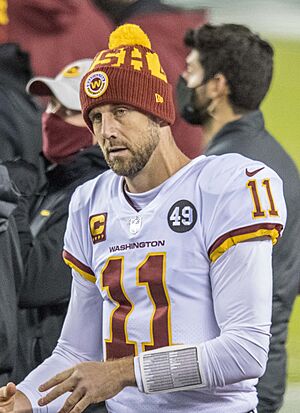
The team made many changes in 2020. They retired the Redskins name and logo. They hired former Carolina Panthers head coach Ron Rivera. Jason Wright was named team president, the first black person in that role in NFL history. Jack Del Rio became defensive coordinator and Scott Turner became offensive coordinator.
Under Rivera and Del Rio, the team changed its defensive style. They drafted Chase Young, who was named Defensive Rookie of the Year. Dwayne Haskins was released before the season ended. Despite this, Washington won the division for the first time since 2015. They did it with a 7–9 record. They were only the third team in NFL history to win a division with a losing record in a non-strike year.
In 2020, some minority owners wanted to sell their share of the team. In April 2021, Daniel Snyder bought the remaining 40 percent of the team.
Other changes in 2021 included hiring Martin Mayhew as general manager. Washington became the first NFL team to have a minority general manager, head coach, and president at the same time. Ryan Kerrigan, the team's all-time sack leader, left to play for the Philadelphia Eagles.
The team rebranded as the Commanders in 2022. Their fight song returned with new words as "Hail to the Commanders". Their cheerleading squad was replaced by a co-ed performance group called the Command Force. The team also traded for Colts quarterback Carson Wentz.
Logos and Uniforms
The team's main colors are burgundy and gold. From 1961 to 1978, Washington wore gold pants with both burgundy and white jerseys. Gold face masks were added in 1978 and are still used today. For many years, Washington was one of only three teams that mostly wore white jerseys at home. This tradition started in 1981 when Joe Gibbs became coach.
Their burgundy jerseys were usually worn only when the other team wore white at home. This often happened against the Dallas Cowboys. From 1981 to 2000, Washington almost always wore white jerseys over burgundy pants at home. In 1994, for the NFL's 75th anniversary, the team wore special throwback uniforms. These looked like the uniforms from 1937.
In 2001, the team wore burgundy for all home games. In 2002, for their 70th anniversary, they wore a special home uniform. It was a burgundy jersey over gold pants. This looked like the uniforms from 1969 to 1978. When Gibbs returned as coach in 2004, the team went back to wearing white jerseys at home.
The team has worn all-white uniforms. This combination first appeared in 2003. The Redskins won six straight games wearing them, including a playoff game. In 2006, the white jersey over burgundy pants look returned for a home game.
For their 75th anniversary in 2007, Washington wore a special throwback uniform. It was based on their away uniform from 1970 to 1971. The helmet was gold with a burgundy "R" logo. This helmet was inspired by Vince Lombardi.
In 2008, Washington wore all-burgundy uniforms for a game. This look appeared two more times in 2009. Starting in 2010, the Redskins began wearing burgundy jerseys with gold pants. This was like the George Allen era. Later that season, they wore gold pants with their usual white jerseys for the first time.
In 2011, the Redskins wore different uniform combinations. In 2012, the team wore an updated throwback uniform from the 1937 championship team. It had a helmet pattern based on the old leather helmets. In 2013, a new NFL rule said teams could not wear alternate helmets. So, Washington wore their 1937 throwbacks with the logo removed from their regular helmet.
Between 2014 and 2016, the team mostly wore gold pants with their standard uniforms. In 2017, Washington brought back the all-burgundy uniform for the NFL Color Rush. In 2018, Washington used white pants for most of their home games.
When the team changed its name to the Washington Football Team in 2020, they got new logos and uniforms. Their new logo was a simple "W". The helmet logo and stripes were replaced with the player's jersey number in gold. The all-white uniform combination also returned.
The Commanders rebranding in 2022 included new logos and uniforms. They have military-inspired designs. The main home uniform is burgundy with gold and white stripes. The numbers are gold with white trim. The team name is above the numbers. The road white uniform has burgundy and white numbers with black trim. Both sets can be worn with burgundy or white pants. There is also an alternate black uniform. It has the team name on the left chest in gold. The numbers are gold with burgundy trim. Black pants are worn with this uniform. There is also an alternate black helmet with the "W" logo.
Rivalries
Dallas Cowboys
The Commanders have a big rivalry with the Dallas Cowboys. These two teams have won 31 division titles and 10 championships combined. This includes eight combined Super Bowls. The rivalry began in 1960 when the Cowboys joined the league. Since 1961, they have played each other twice every regular season.
The rivalry has an interesting start. In 1958, Clint Murchison Jr. wanted to bring an NFL team to Dallas. He heard that George Preston Marshall, the Redskins owner, wanted to sell his team. But Marshall changed the terms at the last minute. Murchison was very upset. Marshall also had a disagreement with the Redskins' band director, Barnee Breeskin. Breeskin wrote the team's fight song, "Hail to the Commanders". Breeskin sold the rights to the song to Murchison for $2,500.
Murchison then decided to create his own team. NFL chairman George Halas supported him. But all NFL owners had to agree, and Marshall was against it. When Marshall found out Murchison owned the rights to his team's fight song, a deal was made. If Marshall approved the Dallas team, Murchison would return the song. That is how the Cowboys were founded in 1960.
Philadelphia Eagles
New York Giants
Players and Staff
Current Roster
|
Washington Commanders roster
|
|||||||||
|---|---|---|---|---|---|---|---|---|---|
Quarterbacks
Running backs
Wide receivers
Tight ends
|
Offensive linemen
Defensive linemen
|
Linebackers
Defensive backs
Special teams
|
Reserve lists
→ AFC rosters → NFC rosters |
||||||
Coaching Staff
|
→ Coaching staff |
|||||
Retired Numbers
The Commanders have officially retired four jersey numbers.
| Washington Commanders Retired Numbers | |||
| Number | Player | Position | Years Played |
|---|---|---|---|
| 9 | Sonny Jurgensen | QB | 1964–1974 |
| 21 | Sean Taylor | FS | 2004–2007 |
| 33 | Sammy Baugh | QB, S, P | 1937–1952 |
| 49 | Bobby Mitchell | RB, WR | 1962–1968 |
Unofficially Retired Numbers
Some numbers are not officially retired but are usually not given to new players. These include:
- 7 Joe Theismann, QB, 1974–1985
- 28 Darrell Green, CB, 1983–2002
- 42 Charley Taylor, WR, 1964–1977
- 43 Larry Brown, RB, 1969–1976
- 44 John Riggins, RB, 1976–1979, 1981–1985
- 65 Dave Butz, DT, 1975–1988
- 70 Sam Huff, LB, 1964–1969
- 81 Art Monk, WR, 1980–1993
Pro Football Hall of Fame Members
Many players and coaches from the Washington Commanders are in the Pro Football Hall of Fame. Names in bold mean they were mainly recognized for their time with Washington.
| Washington Players and Personnel in the Pro Football Hall of Fame | |||||||||
|---|---|---|---|---|---|---|---|---|---|
| Players | |||||||||
| No. | Name | Positions | Seasons | Inducted | No. | Name | Positions | Seasons | Inducted |
| 9 | Sonny Jurgensen | QB | 1964–1974 | 1983 | 17 | Turk Edwards | OT/DT | 1932–1940 | 1969 |
| 20 | Cliff Battles | RB–CB | 1932–1937 | 1968 | 21 | Deion Sanders | CB | 2000 | 2011 |
| 26 | Paul Krause | S | 1964–1967 | 1998 | 26 | Don Shula | DB | 1957 | 1997 |
| 27 | Ken Houston | S | 1973–1980 | 1986 | 28 | Darrell Green | CB | 1983–2002 | 2008 |
| 33 | Sammy Baugh | QB–S–P | 1937–1952 | 1963 | 35 | Bill Dudley | RB/CB | 1950–1953 | 1966 |
| 40 | Wayne Millner | TE–DE | 1936–1941 | 1968 | 42 | Charley Taylor | WR | 1964–1977 | 1984 |
| 44 | John Riggins | RB | 1976–1985 | 1992 | 49 | Bobby Mitchell | RB | 1962–1968 | 1983 |
| 55 | Chris Hanburger | LB | 1965–1978 | 2011 | 68 | Russ Grimm | G | 1981–1991 | 2010 |
| 70 | Sam Huff | LB | 1964–1969 | 1982 | 73 | Stan Jones | DT | 1966 | 1991 |
| 75 | Deacon Jones | DE | 1974 | 1980 | 78 | Bruce Smith | DE | 2000–2003 | 2009 |
| 81 | Art Monk | WR | 1980–1993 | 2008 | 89 | Dave Robinson | LB | 1973–1974 | 2013 |
| 60 | Dick Stanfel | OG | 1956–1958 | 2016 | 55 | Jason Taylor | DE/LB | 2008 | 2017 |
| 24 | Champ Bailey | CB | 1999–2003 | 2019 | |||||
| Management | |||||||||
| Name | Positions | Seasons | Inducted | Name | Positions | Seasons | Inducted | ||
| George Allen | Head coach | 1971–1977 | 2002 | Ray Flaherty | Head coach | 1936–1942 | 1976 | ||
| Joe Gibbs | Head coach | 1981–1992 2004–2007 |
1996 | Curly Lambeau | Head coach | 1952–1953 | 1963 | ||
| Vince Lombardi | Head coach | 1969 | 1971 | George Preston Marshall | Owner and founder | 1932–1969 | 1963 | ||
| Bobby Beathard | General manager | 1978–1989 | 2018 | ||||||
Ring of Fame
When the team left RFK Stadium in 1996, they started a new tradition. They honor team legends in the "Ring of Fame" at FedExField. This is a set of signs on the upper level of the stadium. Unlike the old Hall of Stars, the Ring of Fame only honors Redskins/Commanders greats. Team founder George Preston Marshall was removed from the Ring of Fame in 2020. Players highlighted in yellow are also in the Pro Football Hall of Fame.
| Washington Ring of Fame | |||
| No. | Name | Position | Tenure |
|---|---|---|---|
| N/A | George Allen | Head coach | 1971–1977 |
| 41 | Mike Bass | CB | 1969–1975 |
| 20 | Cliff Battles | RB | 1932–1937 |
| 33 | Sammy Baugh | QB | 1937–1952 |
| N/A | Bobby Beathard | General manager | 1978–1988 |
| 53 | Jeff Bostic | C | 1980–1993 |
| 80 | Gene Brito | DE | 1951–1953 1955–1958 |
| 43 | Larry Brown | RB | 1969–1976 |
| 65 | Dave Butz | DT | 1975–1988 |
| 84 | Gary Clark | WR | 1985–1992 |
| 51 | Monte Coleman | LB | 1979–1994 |
| N/A | Jack Kent Cooke | Owner | 1961–1997 |
| 35 | Bill Dudley | RB | 1950–1951, 1953 |
| 37 | Pat Fischer | CB | 1968–1977 |
| 59 | London Fletcher | LB | 2007–2013 |
| N/A | Joe Gibbs | Head coach | 1981–1992 2004–2007 |
| 28 | Darrell Green | CB | 1983–2002 |
| 68 | Russ Grimm | G | 1981–1991 |
| 55 | Chris Hanburger | LB | 1965–1978 |
| 57 | Ken Harvey | LB | 1994–1998 |
| 56 | Len Hauss | C | 1964–1977 |
| N/A | Phil Hochberg | PA announcer | 1963–2000 |
| 27 | Ken Houston | S | 1973–1980 |
| 70 | Sam Huff | LB | 1964–1967, 1969 |
| 66 | Joe Jacoby | OT, G | 1981–1993 |
| 47 | Dick James | RB | 1956–1963 |
| 9 | Sonny Jurgensen | QB | 1964–1974 |
| 22 | Charlie Justice | RB | 1950, 1952–1954 |
| 17 | Billy Kilmer | QB | 1971–1978 |
| 26 | Paul Krause | DB | 1964–67 |
| 79 | Jim Lachey | OT | 1988–95 |
| 14 | Eddie LeBaron | QB | 1952–1953 1955–1959 |
| N/A | Vince Lombardi | Head coach | 1969 |
| 72 | Dexter Manley | DE | 1981–1989 |
| 71 | Charles Mann | DE | 1983–1993 |
| 40 | Wayne Millner | E | 1936–1941, 1945 |
| 49 | Bobby Mitchell | WR | 1962–1968 |
| 30 | Brian Mitchell | RB, RS | 1990–1999 |
| 81 | Art Monk | WR | 1980–1993 |
| 3 | Mark Moseley | K | 1974–1986 |
| 23 | Brig Owens | DB | 1966–1977 |
| 16 | Richie Petitbon | S Defensive coordinator/head coach |
1971–1972 1981–1992 1993 |
| 65 | Vince Promuto | G | 1960–1970 |
| 44 | John Riggins | RB | 1976–1979 1981–1985 |
| 60 | Chris Samuels | OT | 2000–2009 |
| 87 | Jerry Smith | TE | 1965–1977 |
| 42 | Charley Taylor | WR | 1964–1977 |
| 21 | Sean Taylor | S | 2004–2007 |
| 7 | Joe Theismann | QB | 1974–1985 |
| N/A | Lamar "Bubba" Tyer | Athletic trainer | 1971–2002 2004–2008 |
| 17 | Doug Williams | QB | 1986–1989 |
Individual Awards
| MVP | ||
| Season | Player | Position |
|---|---|---|
| 1972 | Larry Brown | RB |
| 1982 | Mark Moseley | K |
| 1983 | Joe Theismann | QB |
| Offensive Player of the Year | ||
| Season | Player | Position |
|---|---|---|
| 1972 | Larry Brown | RB |
| 1983 | Joe Theismann | QB |
| Offensive Rookie of the Year | ||
| Season | Player | Position |
|---|---|---|
| 1975 | Mike Thomas | RB |
| 2012 | Robert Griffin III | QB |
| Defensive Rookie of the Year | ||
| Season | Player | Position |
|---|---|---|
| 2020 | Chase Young | DE |
| Comeback Player of the Year | ||
| Season | Player | Position |
|---|---|---|
| 2020 | Alex Smith | QB |
| Super Bowl MVP | ||
| Super Bowl | Player | Position |
|---|---|---|
| XVII | John Riggins | RB |
| XXII | Doug Williams | QB |
| XXVI | Mark Rypien | QB |
| Coach of the Year | |
| Season | Coach |
|---|---|
| 1971 | George Allen |
| 1979 | Jack Pardee |
| 1982 | Joe Gibbs |
| 1983 | |
Command Force
The Command Force is the team's professional dance and performance group. They started in 1962 as cheerleaders called the Redskinettes. When the team became the Commanders in 2022, they were renamed the Command Force. They are also known as the First Ladies of Football.
Team Records
Single-Game Records
- Receptions: 14 Roy Helu (2011)
- Completions: 33 Jason Campbell (2007), Kirk Cousins (2015)
- Longest field goal: 59 yards Graham Gano (2011)
- Sacks: 4 Dexter Manley (1988), Ken Harvey (1997), Phillip Daniels (2005), Brian Orakpo (2009), Ryan Kerrigan (2014)
- Interceptions: 4 Deangelo Hall (2010)
Season Records
- Passing yards: 4,917 Kirk Cousins (2016)
- Passing touchdowns: 31 Sonny Jurgensen (1967)
- Rushing yards: 1,613 Alfred Morris (2012)
- Receptions: 113 Pierre Garçon (2013)
- Receiving yards: 1,483 Santana Moss (2005)
- Pass interceptions: 13 Dan Sandifer (1948)
- Sacks: 18.5 Dexter Manley (1986)
- Forced fumbles: 6 LaVar Arrington (2003)
- Field goals made: 33 Mark Moseley (1983)
- Points: 161 Mark Moseley (1983)
- Total touchdowns: 24 John Riggins (1983)
- Punt return average (minimum 5 returns): 24.3 yards Derrick Shepard (1987)
- Kickoff return average (minimum 5 returns): 42.8 yards Hall Haynes (1950)
- Punting average: 51.4 yards* Sammy Baugh (1940)
* Also an NFL record
Franchise Records
- Passing yards: 25,206 Joe Theismann (1974–1985)
- Passing touchdowns: 187 Sammy Baugh (1937–1952)
- Rushing yards: 7,472 John Riggins (1976–1979, 1981–1985)
- Receptions: 889 Art Monk (1980–1993)
- Receiving yards: 12,029 Art Monk (1980–1993)
- Pass interceptions: 54 Darrell Green (1983–2002)
- Field goals made: 263 Mark Moseley (1974–1986)
- Points: 1,207 Mark Moseley (1974–1986)
- Total touchdowns: 90 Charley Taylor (1964–1977)
- Punt return average (minimum 25 returns): 13.8.0 Bob Seymour (1941–1944)
- Kickoff return average (minimum 25 returns): 28.5 Bobby Mitchell (1962–1968)
- Punting average: 45.1 Sammy Baugh (1937–1952)
- Sacks: 95.5 Ryan Kerrigan (2011–2020)
- Forced fumbles: 17 Charles Mann (1983–1993)
NFL Records Held by the Team
Offense Records
- The Redskins scored 541 points in 1983. This is the sixth highest total in a season ever.
- The Redskins scored 72 points against the New York Giants on November 27, 1966. This is the most points ever scored by an NFL team in a regular-season game. The final score was 72–41, making it the highest-scoring game in NFL history.
- The Redskins set a record with 39 first downs in a game against the Lions on November 4, 1990. They also set a record by not allowing a single first down against the Giants on September 27, 1942.
- The Redskins have led the league in passing eight times. Only the San Diego Chargers have led more often.
- The Redskins allowed only nine sacks in 1991. This is the third-fewest allowed in a season.
Defense Records
- The Redskins recovered eight of their opponent's fumbles against the St. Louis Cardinals on October 25, 1976. This is the most ever in one game.
- The Redskins allowed only 82 first downs in 1937. This is the third fewest all-time.
- The Redskins have led the league in fewest total yards allowed five times. Their three consecutive years from 1935 to 1937 is an NFL record.
- The Redskins had 61 defensive turnovers in 1983. This is the third most all-time. Their turnover difference of +43 that year was the highest ever.
Special Teams Records
- The Redskins led the league in field goals for eight seasons. Only the Green Bay Packers have led more.
- The Redskins and Bears attempted an NFL record 11 field goals on November 14, 1971. The Redskins and Giants tied that record on November 14, 1976.
- The Redskins had 28 consecutive games with a field goal from 1988 to 1990. This is the third longest streak ever.
- The Redskins have led the league in punting average six times. Their four consecutive years from 1940 to 1943 is an NFL record.
- The Redskins have led the league in average kickoff return yards eight times. This is more than any other team.
Images for kids
-
U.S. President Richard Nixon meeting with the team in 1971
-
FedExField is the current home of the Commanders
-
Clinton Portis with the Redskins, 2007
-
Sean Taylor, the team's first-round draft choice in 2004, was shot and killed by home invaders in 2007 while rehabbing from an injury.
-
Quarterback Robert Griffin III, the team's first-round draft choice in 2012, was named Offensive Rookie of the Year after leading the team to their first division title since 1999.
-
Having fully recovered from a life-threatening leg injury from 2018, quarterback Alex Smith helped lead the team to a NFC East division title in 2020, earning the NFL Comeback Player of the Year award in the process.
See also
 In Spanish: Washington Commanders para niños
In Spanish: Washington Commanders para niños



